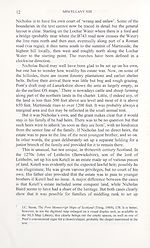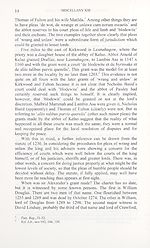Series 5 > Miscellany [of the Scottish History Society] XIII
(28) Page 13
Download files
Complete book:
Individual page:
Thumbnail gallery: Grid view | List view

EIGHT THIRTEENTH-CENTURY TEXTS
13
younger (or possibly illegitimate) sons on their own without looking
for an advantageous marriage. In both cases the provisions for
succession by specified branches of a family foreshadow future
tailzies. How the line of succession of the Bairds of Kirkwood actually
worked out is obscure, but there was certainly a Baird there in 1399.1
The new Baird estate was not entirely independent. It owed
attendance at the court of the senior Bairds and twelve pence for any
‘forfeiture’ (forisfactura).2 But Nicholas was also to have his own
‘free court’ of ‘Wrang et Unlawe’. The earliest use of this term seems
to be in a royal statute of 1230, referring to pleas of ‘wrang et
unreason’.3 A slightly earlier reference to ‘unlaw’ occurs in an
unprinted charter in which Alwin son of Duncan of Foffarty grants
land in Angus to Malbrid Marrenah, specifying that ‘Malbrid will
have merchet and blodwit and unlaw freely as much as pertains to the
land’.4 ‘Merchet’ need not concern us further for this discussion;
‘blodwit’ appears again soon. The statute of 1230 deals with
procedural abuses; it does not define the pleas or indicate their status.
But if procedural abuses had occurred the pleas must have been a part
of judicial arrangements for some years before 1230, and this
inference is supported by the earlier evidence for a grant of ‘unlaw’. A
grant of ‘wrang and unlaw’ to Nicholas Baird is thus no innovation.
Although the Baird charter may now be the second earliest known use
of the full term, it unfortunately does not define it. That in itself
suggests that by the mid-thirteenth century it had a commonly
recognised content of jurisdiction. The charter makes clear that
Nicholas could take forfeitures and escheats, that is, to exact penalties,
probably of money or livestock or both, no doubt for minor offences.
The grant makes no reference to sac and soc, or to pit and gallows,
which sir Alexander Baird presumably had himself, but he was giving,
it seems, the jurisdiction appropriate to a court below the level of his
own.
This interpretation is echoed by an almost contemporary (cl272)
grant by the abbot of Paisley of the lands of Fulton (Refrewshire) to
1 HMC, Home, no. 291; Miscellany V (Scottish History Society, 1933), 45-46.
2 Charters of the Abbey of Coupar Angus (Scottish History Society, 1947), 18-19;
Charters, Bulls and other Documents relating to the Abbey of Inchaffray (Scottish
History Society, 1908), nos 43-44; Glas. Reg., nos 85-87 are other early 13th
century examples defining the responsibilities of courts.
3 APS, i, 402 red.
4 British Library, Add. Ch. 76748. Professors Barrow and MacQueen have been very
helpfiil in drawing this to my attention and in providing a text and photocopy. It is
datable to the early 1200s.
13
younger (or possibly illegitimate) sons on their own without looking
for an advantageous marriage. In both cases the provisions for
succession by specified branches of a family foreshadow future
tailzies. How the line of succession of the Bairds of Kirkwood actually
worked out is obscure, but there was certainly a Baird there in 1399.1
The new Baird estate was not entirely independent. It owed
attendance at the court of the senior Bairds and twelve pence for any
‘forfeiture’ (forisfactura).2 But Nicholas was also to have his own
‘free court’ of ‘Wrang et Unlawe’. The earliest use of this term seems
to be in a royal statute of 1230, referring to pleas of ‘wrang et
unreason’.3 A slightly earlier reference to ‘unlaw’ occurs in an
unprinted charter in which Alwin son of Duncan of Foffarty grants
land in Angus to Malbrid Marrenah, specifying that ‘Malbrid will
have merchet and blodwit and unlaw freely as much as pertains to the
land’.4 ‘Merchet’ need not concern us further for this discussion;
‘blodwit’ appears again soon. The statute of 1230 deals with
procedural abuses; it does not define the pleas or indicate their status.
But if procedural abuses had occurred the pleas must have been a part
of judicial arrangements for some years before 1230, and this
inference is supported by the earlier evidence for a grant of ‘unlaw’. A
grant of ‘wrang and unlaw’ to Nicholas Baird is thus no innovation.
Although the Baird charter may now be the second earliest known use
of the full term, it unfortunately does not define it. That in itself
suggests that by the mid-thirteenth century it had a commonly
recognised content of jurisdiction. The charter makes clear that
Nicholas could take forfeitures and escheats, that is, to exact penalties,
probably of money or livestock or both, no doubt for minor offences.
The grant makes no reference to sac and soc, or to pit and gallows,
which sir Alexander Baird presumably had himself, but he was giving,
it seems, the jurisdiction appropriate to a court below the level of his
own.
This interpretation is echoed by an almost contemporary (cl272)
grant by the abbot of Paisley of the lands of Fulton (Refrewshire) to
1 HMC, Home, no. 291; Miscellany V (Scottish History Society, 1933), 45-46.
2 Charters of the Abbey of Coupar Angus (Scottish History Society, 1947), 18-19;
Charters, Bulls and other Documents relating to the Abbey of Inchaffray (Scottish
History Society, 1908), nos 43-44; Glas. Reg., nos 85-87 are other early 13th
century examples defining the responsibilities of courts.
3 APS, i, 402 red.
4 British Library, Add. Ch. 76748. Professors Barrow and MacQueen have been very
helpfiil in drawing this to my attention and in providing a text and photocopy. It is
datable to the early 1200s.
Set display mode to:
![]() Universal Viewer |
Universal Viewer | ![]() Mirador |
Large image | Transcription
Mirador |
Large image | Transcription
Images and transcriptions on this page, including medium image downloads, may be used under the Creative Commons Attribution 4.0 International Licence unless otherwise stated. ![]()
| Scottish History Society volumes > Series 5 > Miscellany [of the Scottish History Society] XIII > (28) Page 13 |
|---|
| Permanent URL | https://digital.nls.uk/127313865 |
|---|
| Description | Over 180 volumes, published by the Scottish History Society, containing original sources on Scotland's history and people. With a wide range of subjects, the books collectively cover all periods from the 12th to 20th centuries, and reflect changing trends in Scottish history. Sources are accompanied by scholarly interpretation, references and bibliographies. Volumes are usually published annually, and more digitised volumes will be added as they become available. |
|---|


